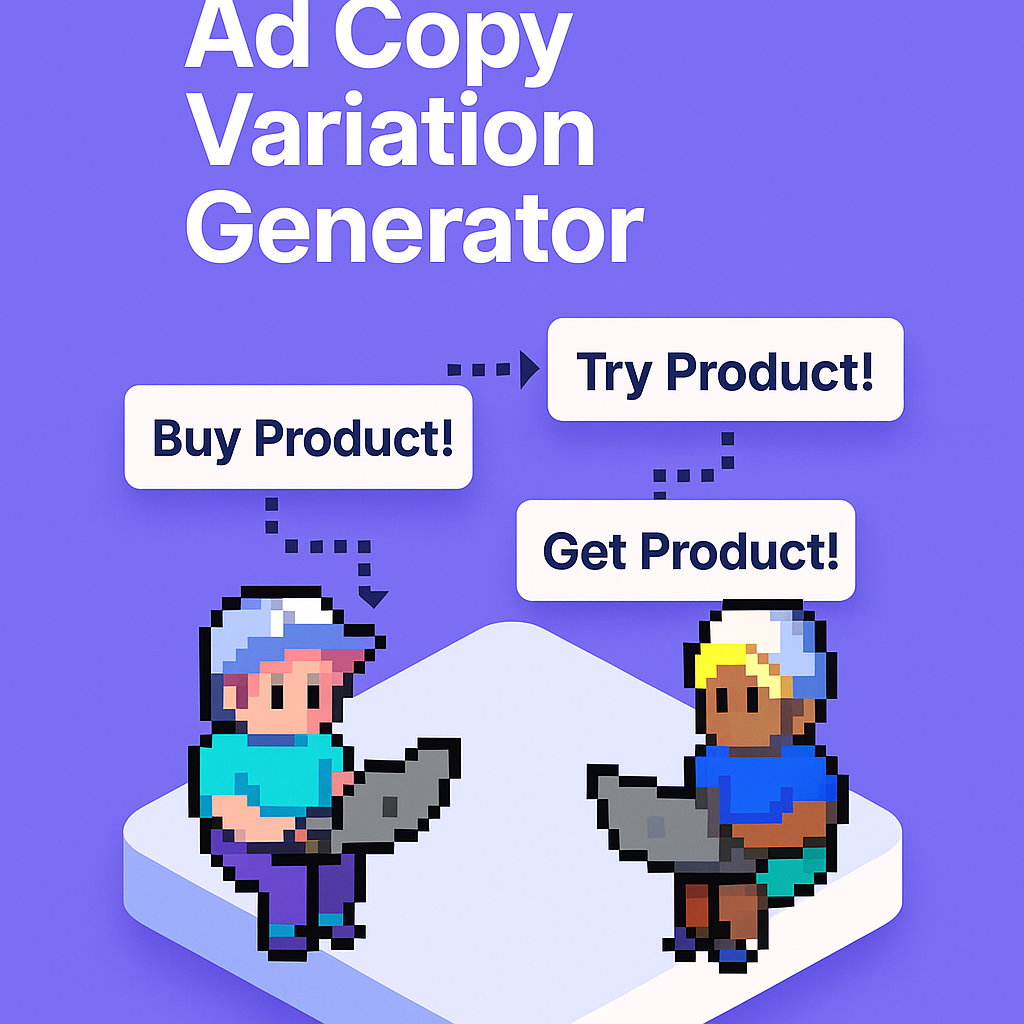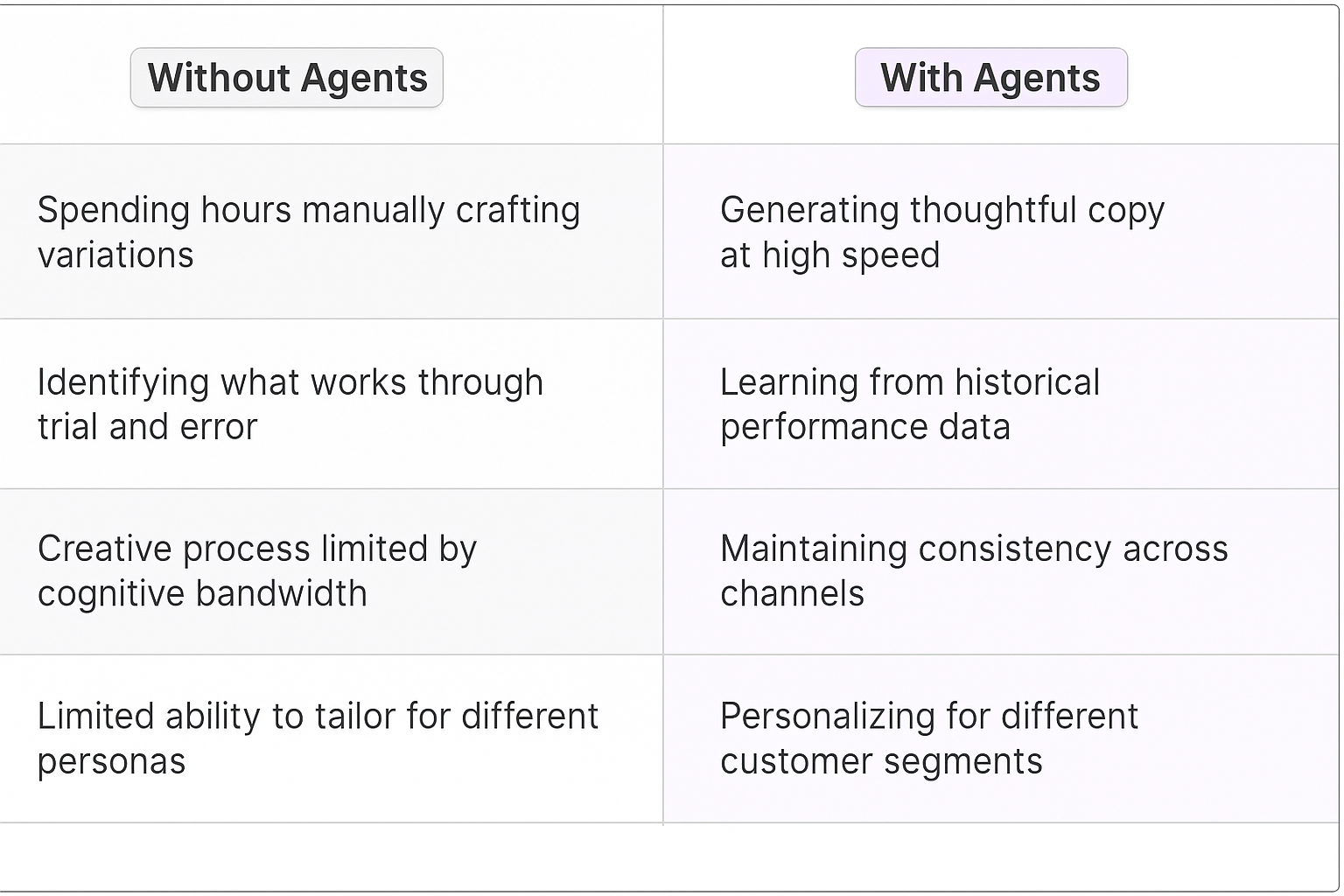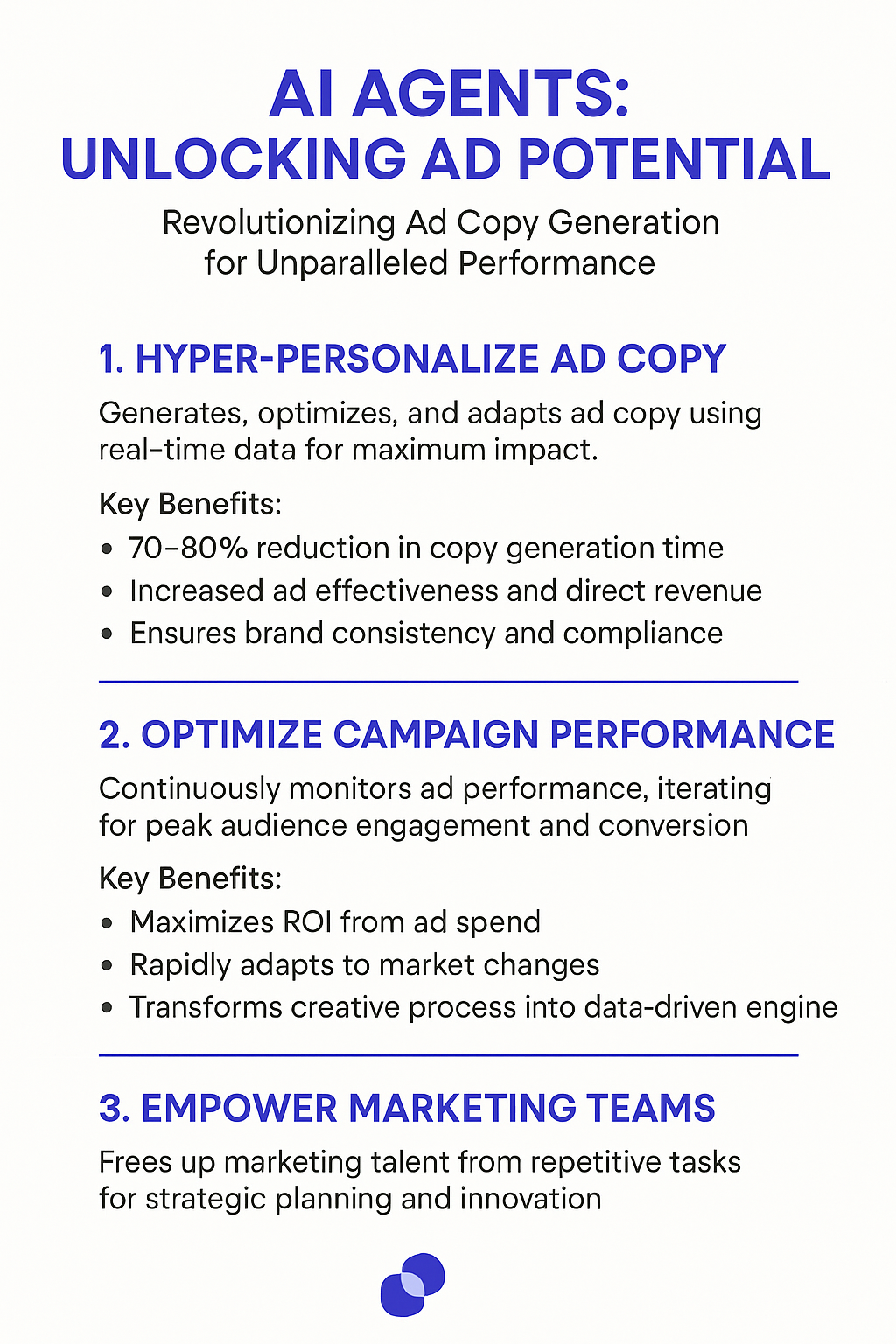Ad Copy Variation Generator AI Agents
Understanding AI-Powered Ad Copy Generation
Ad Copy Variation Generator is a specialized AI system that creates multiple versions of advertising copy based on historical performance data, brand guidelines, and marketing objectives. Unlike basic text generators, these digital teammates understand nuanced marketing principles, psychological triggers, and platform-specific requirements. They can produce hundreds of thoughtful variations while maintaining consistent brand voice and messaging strategy.
Key Features of Ad Copy Variation Generator
- Performance-driven learning that incorporates data from successful campaigns
- Multi-platform optimization for different ad formats and requirements
- Brand voice preservation across all generated variations
- Audience segment targeting through personalized messaging
- A/B testing integration for continuous optimization
- Compliance checking for regulated industries
- Real-time adaptation based on campaign performance metrics

Benefits of AI Agents for Ad Copy Variation Generator
What would have been used before AI Agents?
The traditional ad copy creation process has been a massive time sink for growth teams. I've worked with countless startups where marketers spend hours manually crafting variations, often recycling old templates or playing mad libs with existing copy. They'd maintain sprawling spreadsheets of previous campaigns, trying to identify what worked through pure trial and error. Junior copywriters would churn through variations, but the creative process was fundamentally limited by human cognitive bandwidth.
What are the benefits of AI Agents?
The introduction of AI Agents into the ad copy workflow creates a 10x improvement in both velocity and creative exploration. These digital teammates can generate hundreds of thoughtful variations while maintaining brand voice and conversion principles. But the real power isn't just in raw output - it's in the systematic learning.
When you deploy an AI Agent for ad copy, you're essentially creating a specialized creative partner that:
- Absorbs historical performance data to understand what messaging resonates with different audience segments
- Maintains consistency across channels while testing subtle variations that humans might miss
- Generates copy that follows proven psychological triggers and persuasion frameworks
- Scales personalization by crafting variations for different customer personas
- Eliminates the cognitive overhead of "blank page syndrome" for marketing teams
The network effects here are fascinating - each new piece of copy generated and tested makes the system smarter. Growth teams can focus on high-level strategy and customer insight while their AI teammate handles the heavy lifting of variation creation. This is a classic example of technology expanding the possible rather than just automating the existing.
The most successful teams I've seen pair human creativity with AI generation capabilities - using the technology to explore creative directions they wouldn't have time to pursue otherwise. This creates a compounding advantage as marketing experiments can run faster and generate more learning.
Potential Use Cases of Ad Copy Variation Generator AI Agents
Processes
- A/B testing optimization by generating multiple ad variations based on successful historical campaigns
- Rapid creation of localized ad copy for different geographic markets while maintaining brand voice
- Scaling seasonal promotional campaigns across multiple product lines
- Adapting existing ad copy to different ad platforms while following platform-specific requirements
- Creating personalized ad variations for different customer segments
Tasks
- Generate 20+ headline variations for Facebook ad campaigns testing different value propositions
- Create multiple body copy versions emphasizing different product features and benefits
- Adapt successful ad copy into different lengths for various placements (headlines, descriptions, etc.)
- Transform product specifications into compelling benefit-focused ad copy
- Generate call-to-action variations to test user response and conversion rates
- Create ad copy variations that target different stages of the customer journey
- Develop multiple versions of social proof and testimonial-based ads
Growth Marketing Perspective
The real power of ad copy variation generators lies in their ability to scale creative testing. When running growth experiments, the limiting factor is often how quickly we can generate and test new creative concepts. Traditional approaches might yield 3-4 variations, but AI agents can generate 50+ thoughtful variations in minutes.
The key insight many miss: it's not just about mass-producing variations - it's about intelligent iteration. These digital teammates learn from performance data, incorporating winning elements into new variations while dropping underperforming patterns. This creates a continuous optimization loop that would be impossible to maintain manually.
For growth teams, this means running deeper creative tests across more audience segments simultaneously. Instead of broad, generic messages, each segment gets multiple tailored variations, dramatically improving campaign performance through personalization at scale.
The most sophisticated teams are using these AI agents as creative partners - feeding them winning ads from competitors, successful email campaigns, and customer reviews to generate novel combinations that maintain brand voice while pushing creative boundaries.

Industry Use Cases
Ad copy variation generators powered by AI are fundamentally changing how marketing teams operate across industries. The ability to rapidly test and iterate on ad creative while maintaining brand voice has moved from a "nice to have" to a critical competitive advantage.
What's particularly fascinating is how different sectors leverage these digital teammates in unique ways - each adapting the technology to their specific market dynamics and customer behaviors. The real power comes from combining human creative direction with AI's ability to generate and test hundreds of variations at scale.
When we look at adoption patterns across industries, we're seeing the most sophisticated teams using AI not just for basic copy generation, but as a strategic tool for discovering new messaging angles and audience segments. This creates a powerful feedback loop where each generated variation provides insights that inform future creative direction.
The shift happening now mirrors what we saw with the adoption of A/B testing tools a decade ago - early adopters who master these capabilities are building significant advantages in their customer acquisition efforts. The key difference is the speed and scale at which teams can now experiment with messaging.
E-commerce: Scaling Ad Creative Without Burning Out
Running an e-commerce brand means constantly testing new ad variations across multiple platforms. The brutal reality? Most marketing teams get stuck in a creative rut after their first 50 ad variations. I've seen this pattern repeat across hundreds of D2C brands - they start strong but hit diminishing returns as creative fatigue sets in.
Ad Copy Variation Generator AI agents flip this dynamic on its head. Take MVMT Watches, who deployed an AI agent to generate thousands of unique ad copy variations for their minimalist timepieces. The AI analyzed their top-performing ads and brand voice, then produced fresh angles that maintained brand consistency while exploring new messaging territories.
The results were striking: Their marketing team shifted from spending 70% of their time writing variations to focusing on high-level strategy and creative direction. The AI agent generated 300+ unique copy variations per product line, each maintaining MVMT's signature tone while testing different value propositions and emotional triggers.
What's particularly fascinating is how the AI agent learned from performance data. When variations emphasizing "confidence" and "sophistication" outperformed those focused on "affordability," the system automatically generated more copy in that direction. This created a powerful feedback loop that continuously refined the messaging approach.
The key insight? AI agents don't replace creative teams - they amplify them. MVMT's marketers became creative directors, focusing on big-picture strategy while their digital teammate handled the heavy lifting of variation generation. This is the future of marketing operations: humans setting creative vision while AI scales execution.
Real Estate: Converting Leads Through Personalized Property Ads
I've spent years analyzing how real estate firms struggle with ad personalization at scale. Most agents default to generic property descriptions, missing countless opportunities to connect with specific buyer segments. The math simply doesn't work - writing unique ad copy for every property across multiple buyer personas burns too many hours.
The Corcoran Group, a luxury real estate firm in New York, cracked this code using an Ad Copy Variation Generator AI agent. They fed it their historical ad performance data, buyer segment insights, and property details. The AI began crafting tailored ad variations that spoke directly to different buyer motivations - from investment-focused foreign buyers to local families prioritizing school districts.
The depth of personalization was remarkable. For a single Upper West Side property, the AI generated distinct ad sets highlighting proximity to Lincoln Center for culture enthusiasts, Central Park access for active lifestyles, and property appreciation data for investors. Each variation maintained Corcoran's sophisticated tone while speaking to specific buyer pain points.
What fascinates me most is the compound effect on conversion rates. When the AI agent detected that ads emphasizing "pre-war charm" resonated strongly with a particular demographic, it automatically expanded that theme across relevant properties. The system effectively built a real-time playbook of winning messages for each buyer segment.
The agents' role evolved from copywriting to strategy. Instead of spending mornings crafting property descriptions, they focused on relationship building and deal closing. Their digital teammate handled the nuanced work of creating and testing hundreds of ad variations, effectively turning each property listing into a personalized conversation with potential buyers. The AI excelled at writing unique ad copy that resonated with different buyer personas.

Considerations & Challenges
Technical Integration Hurdles
Implementing an ad copy variation generator requires careful attention to your existing marketing tech stack. The AI models need access to historical performance data and brand guidelines, which often live in different systems. Many marketing teams discover their data isn't as organized or accessible as they initially thought. You'll need clean, structured data about past ad performance, customer segments, and conversion metrics for the AI to learn from effectively.
Quality Control & Brand Voice
While AI can generate countless variations quickly, maintaining consistent brand voice becomes exponentially more complex at scale. The AI may produce technically correct copy that misses subtle brand nuances or cultural references that human copywriters instinctively understand. Setting up proper review workflows and training the AI on your specific brand voice requires significant upfront investment.
Performance Measurement Complexity
Attribution becomes tricky when dealing with AI-generated variations. You'll need sophisticated A/B testing frameworks to properly measure which elements of the generated copy drive results. Many teams struggle to separate the impact of copy variations from other variables like audience targeting or placement. This creates a feedback loop problem - without clear performance data, the AI can't effectively learn and improve.
Resource Requirements
The hidden costs of running an AI copy generator extend beyond the technology itself. You'll need dedicated team members to train the system, review outputs, and continuously refine parameters. Many marketing teams underestimate the human oversight required, especially in the early months. The learning curve for effectively "teaching" the AI your brand standards can be steep.
Regulatory Compliance
Ad copy often needs to meet specific regulatory requirements, particularly in regulated industries like finance or healthcare. Training AI systems to reliably generate compliant copy while maintaining creativity is an ongoing challenge. You'll need robust compliance checking systems and potentially legal review processes for AI-generated content.
The Future of Human-AI Creative Partnership in Marketing
The adoption of Ad Copy Variation Generator AI agents marks a pivotal moment in marketing evolution. We're moving beyond simple automation into true creative partnership between humans and machines. The most successful teams are those who understand this isn't about replacing human creativity - it's about amplifying it. As these systems continue to evolve, the competitive advantage will go to marketers who master the art of creative direction while leveraging AI's ability to execute and learn at scale. The future belongs to hybrid teams where human insight drives strategy while digital teammates handle the heavy lifting of variation creation and optimization.











